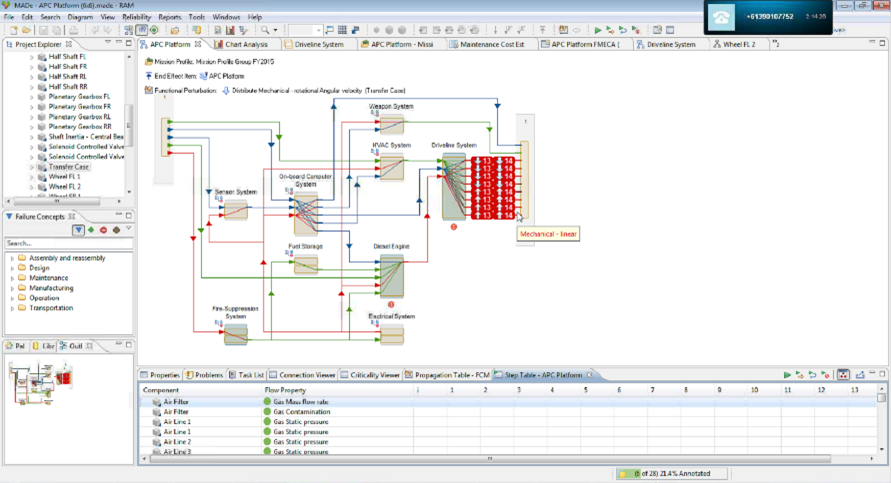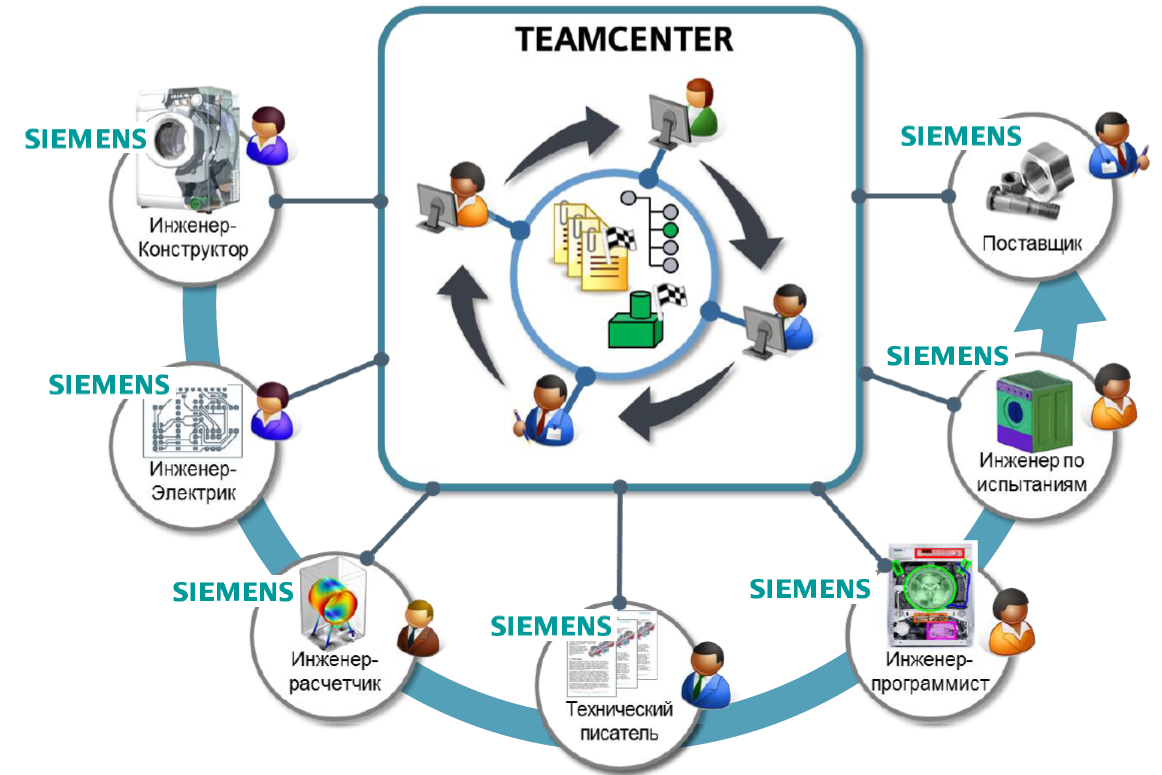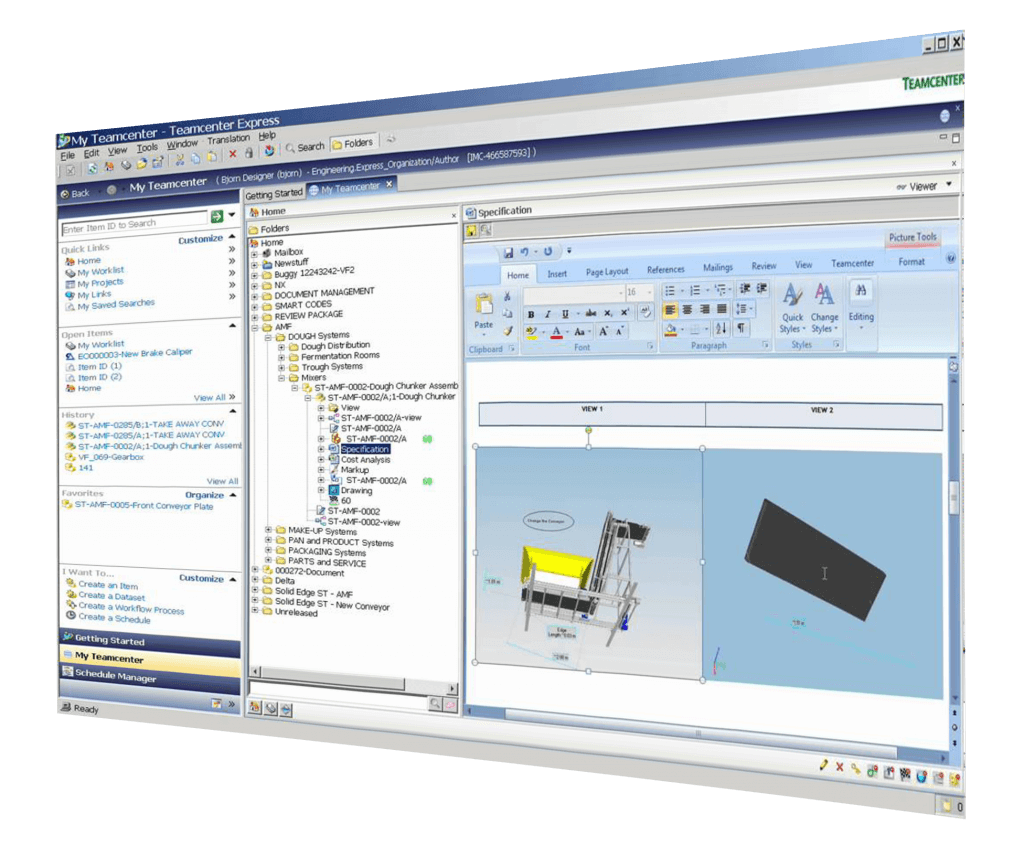The purpose of Query Builder Application in Teamcenter PLM?
- Teamcenter is a cloud-based product lifecycle management platform. It allows users to edit product data and processes such as 3D designs, embedded software, documentation and bill of materials.
- Teamcenter® software allows you to solve more of the tough challenges required to develop better products. The use of Teamcenter helps connect people and processes across various functional silos.
- The Teamcenter® Integration for Solid Edge enables you to improve the quality of your product development process by enhancing your Solid Edge CAD data management and to create a single design data management environment for mechanical, electronic.
- Increased Productivity: Teamcenter improves personal, application, and IT productivity.A variety of clients enable users to quickly view product knowledge attuned to their everyday roles and experiences. Having the right information at the right time is the key to higher productivity and improved decision making.
The Query builder application is an essential tool which enables any user to build customized searches for objects that present in remote or local Teamcenter PLM database. If one is seeking to use the Teamcenter query builder and looking forward to building query definition, then he/she must possess the depth of knowledge of the Teamcenter PLM persistent Object Manager or POM Database scheme. To be precise, it is a hierarchy set up of attributes, classes, sub-classes of the PLM system.
It is an unquestionable thing that Query’s definition is also known as Saved queries. They figure out the search criteria that are made use of for finding information in Teamcenter PLM. It is the duty of administration for end-users to define query definitions. For example, a candidate can build a saved query to find the items that have been transported. They do not support the run-time and compound properties as well.
838 Teamcenter jobs available on Indeed.com. Apply to Team Administrator, Teamcenter System Administration, Senior Consultant and more!
Understanding Query Builder Configuration in Teamcenter PLM
As a Teamcenter PLM user, one has the privilege to use the Query Builder Application. It is also a mere fact that one needs to make sure that you need to pick this feature while installing Teamcenter PLM. It will contravene the need to allow this feature or do additional configuration while using Teamcenter PLM.
Query Builder Interface in Teamcenter PLM

- Saved Queries tree pane: it shows queries that already have in the database.
- Saved query properties pane: It shows the name, description, search type, query type, that is saved and can be selected in the Saved Queries Tree.
- Positioning button in Query Builder: It shows the language Translations dialog box which contains the existing translation values.
- Search Type Button: It shows the Business Type Selection dialog box which contains the query for selection
- Property Selection pane: It shows the attributes of the selected type and also shows the direct attributes of inherited types. One can also choose a display setting.
- Search Criteria pane in Query Builder: It displays the search criteria sections which are using attributes, user entry keys, operators, and default values. Boolean operators can be listed for multiple search criteria section processing to make Teamcenter PLM Query builder more effective.
Query Builder Basic Concepts in Teamcenter PLM
Based on the following features, Teamcenter PLM Query Builder can be utilized to create queries:
- Queries created by making use of the hints feature
- Queries which are based on an existing definition
- Queries which contains a keyword search
- Based on classification attributes
- Queries by making use of IS_NOT_NULL or IS_NULL operators
- Referenced-by queries
- Subclass queries based on a typed reference
Queries created by using the hints feature
In case you seeking assistance in navigating the schema, the queries can be built by making use of the hints. They represent an association to traverse such as item-to-item master form. And, the steps which are required to create that association into a query definition.
Queries which include a keyword search
The instance when you involve the search keyword attribute in query definition, it will help you to develop queries that have Teamcenter PLM dataset files that comprise of the keyword or a specific combination of keywords from the app database. One needs to ensure that the autonomy server is installed and organized at the site so that one can make use of the full-text keyword search functionality.
Queries that are based on an existing definition

Users can have access to existing queries that are already mentioned in Teamcenter PLM.
Queries using the IS_NOT_NULL or IS_NULL operators
These two operators permit you to build queries to find objects that hold a null attributed value such as items without descriptions or items with an attribute that has a value than null. One should know that clauses will be seen as a fixed value that navigates to enter a name and a default value for the clause.
Asus taichi 21 drivers windows 10. Referenced-by queries
Teamcenter Nx
Users can create queries by utilizing sections on a reversed-reference association.
Queries that are based on classification attributes
Queries based on appropriate privileges and attribute functions are essentials. By saving queries on classification properties using Query Builder can be applicable and also one can also be saved query that merges with Teamcenter PLM properties and classification properties.
Teamcenter PLM Query Builder uses the classification hierarchy is the same as the classification hierarchy, which is also get used in the Classification of Teamcenter PLM. The optimum level of this classification involves groups which do not comprise of properties and cannot be applicable in a search, These group nodes will show a unique icon. The nodes which come below the group level will match to a classification type. One can build saved queries by using the type-level nodes.
A Classification object (abbreviated as ICO) is usually attached to a Teamcenter PLM object employing the Tc_classification relationship. This relationship is shown as one of the properties for a Teamcenter type whose instances are deftly classified. For such a Teamcenter type (like the item and item revisions), you as a user can expand its Tc_classification property in the Property Selection tree and use it to access the Classification properties. When you do that, you will build a saved query that combines Teamcenter property search criteria and Classification property search criteria.
A Classification object, popularly called ICO, is basically merged to a Teamcenter PLM object through the Tc_classification relationship. The association will be displayed as a property for Teamcenter type, whose instances are adroitly classified. For such a Teamcenter type, which is usually item and item revisions, a candidate, being a user, can extend its Tc_classification property in the property selection tree. It can also be used to access the classification properties. In order to do that, one needs to create a saved query that merges Teamcenter property search criteria and Classification property search criteria.
Subclass queries on a typed reference
Saved queries in Teamcenter PLM can be built depending on a subtype of a typed reference and then create sections against the subtype property instead of creating clauses against the properties of the referenced type.
For example, the property of content presented in the Folder type is a written reference of the referenced type WorkspaceObject. Thus, the candidate can pick the Dataset type as a referenced type of the content and create query sections against the Dataset type property, and not against the WorkspaceObject type.

Teamcenter PLM Training from PLM Coach
- Teamcenter PLM Functional Training
(https://plmcoach.com/teamcenter-functional-training/)
This course is specially designed for the people who are looking forward to grasping the concept of product cycle management, popularly called PLM. Students who sign up for this course will have an idea about the rich client user interface and will gather the knowledge of the basics of using Teamcenter PLM. In addition to making aware of the know-how of working on the client interface, this course will also provide the knowledge of basics of using different Teamcenter PLM application that covers Change Manager, My Teamcenter, Structure Manager, Embedded Viewer, Workflow Viewer, and Classification, but it is also a fact that the course’s range will not be limited to these concepts.
- Teamcenter PLM Deployment Training
(https://plmcoach.com/teamcenter-deployment/)
Students who sign up for this course will get to imbibe two-tier and four-tier architecture. This course will also endow students with the process of installing the components of two and four-tier architecture. It also gives the flexibility to learn all about the corporate server, the BMIDE, two-tier rich client, database server, etc. This course will also cover web application server, distribution server, four-tier rich client, NX integration, Dispatcher, the processes of installing and configuring server manager, the embedded viewer, distribution server instance, thin client, FSC cache server, Store and Forward, and creating an additional site for Teamcenter PLM.

- Teamcenter PLM Administration Training –
(https://plmcoach.com/teamcenter-administration/)
This course perfectly goes well with the necessities of the students who want to learn the configuration of Teamcenter Administrative Data to support the company’s needs with Rich Client. Signing up for this course will provide you with a thorough picture of the role-focused set of topics that are applicable to application administrations. Also, this course will help you to grok the basics of how to create the manage administrative data in Teamcenter PLM. The key topics which this course encapsulates are project data, import and export rules, configuring and managing a company’s organization, stylesheets, searches, reports, workflows, commands, preferences values, access permissions, and other useful stuff. This course also provides the knowledge of how to migrate to additional sites or how can someone process reports against that data.
- Teamcenter PLM Business Modeler Administration Training (https://plmcoach.com/teamcenter-business-modeler/)

Opting for this course will help students to learn the configuration of the Teamcenter PLM data model to fulfill the company’s needs through the BMIDE. Signing up for this course will push students to learn the set of topics that are taught in the 1st part of the Application and Data Model Administer course that is cohesive for data model administrators and the developers as well. It also makes you aware of the key fundamentals of BMIDE, deployment techniques, the process of extending the data model, and choices that are accessible for initiating changes into development, QA, and production sites. In addition to this, this course also enlightens with an introduction to the (BMIDE) in Teamcenter PLM, the basic of extending the data model with new elements like properties, List of Values(LOVs), business object, deployment strategies as well as troubleshooting, preferences and utility references that are present in Teamcenter PLM, rules, and other important stuff in Teamcenter PLM.
- Teamcenter PLM Server Side (ITK) Customization Training
(URL: https://plmcoach.com/teamcenter-server-customization/) Borderlands 2 season pass code generator.
Choosing this course will educate students about customizing the Team center PLM server, Teamcenter PLM Rich Clients, and standalone ITK and SOA Utilities. It also makes you accustomed to Integrated Toolkit (ITK) and Service-Oriented Architecture (SOA) APIs in Teamcenter PLM. Students can also acquire knowledge on how to build standalone command-line utilities to arouse custom code that is inscribed in either ITK or SOA in Teamcenter PLM.
Teamcenter Plm
By opting for this course, students will be facilitated with a vibrant surrounding in Microsoft Visual Studio and Eclipse. In order to do so, students will learn about debugging and executing their utilities in Teamcenter PLM.
The candidate will also get to learn using SOA and ITK to extend server functionality by building Operations Extensions, Metamodel Operations, and services that are presented inside the Business Modeler and a plethora of deployment know-how to obtains the customization to their clients/server in Teamcenter PLM.
Apart from the above, candidate will also learn creating custom plugins using Eclipse to create custom interface components of Rich Client, which will help to impel server-side code in Teamcenter PLM. The course also covers a discussion on the Style sheet to bring up customization and to move the data display in the clients. Xp pen driver mac.
- Teamcenter PLM Client-Side (RAC) Customization Training (https://plmcoach.com/teamcenter-client-customization/)
Going for this course will help you attain knowledge on customizing Teamcenter PLM Rich Clients by using Java (SWT) and SOA. The course also confers with knowledge on working with or modifying, creating, and registering Style Sheets to influence the display of properties for users to interact with. This method in Teamcenter PLM plays a key role in modifying the user interface (UI) and reduce the number of clicks that are required to performs tasks in Teamcenter PLM.
- Teamcenter PLM Active Workspace (AWC) Customization Training
(https://plmcoach.com/teamcenter-active-workspace-customization/)
Candidates like Active Workspace administrators and developers opt for this course to learn configuring and customize Active workspace. Signing up for this course also makes them aware of configuration for different scopes and tiles to perform a variety of functionality in Teamcenter PLM.
This course also makes candidates acquainted with the process of modifying the feel and look of Teamcenter PLM Client. In order to perform so, the candidate will also witness the involvement of CSS layout, Custom themes, icon configuration, and message notification.
Opting for this course will also feed your cognizance with the declarative approach for customizing the Teamcenter PLM Active Workspace interface. It will work within the Teamcenter PLM Business Modeler IDE to fully influence the visibility of Indexing settings for data model objects, and commands.
The candidate will also get to explore Style Sheer (XRT) improvements and abilities that are fulfilled by making use of custom tags and AngularJS. It works with Visual Studio Code to build a thriving surrounding which can promote the working for debugging for Teamcenter PLM. They will also get to grasp the overview of customizing the TcFTSIndexer to index additional object types, both external and internal.
Teamcenter Latest Version
Show moreTeamcenter Symbol Guide
Teamcenter Plm
